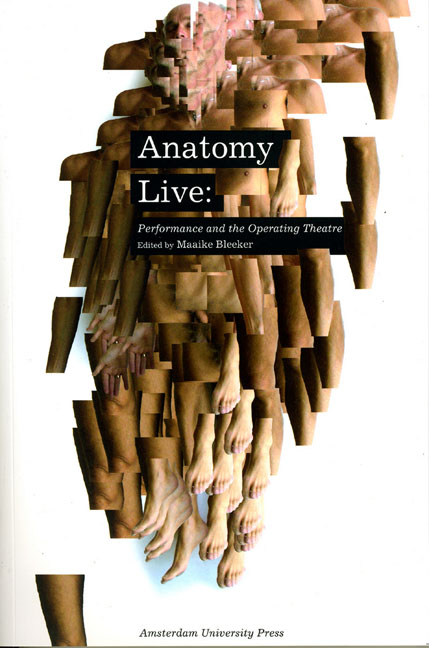Book contents
- Frontmatter
- Contents
- Acknowledgements
- Prologue - Men with Glass Bodies
- Introduction
- Performance Documentation 1: Holoman; Digital Cadaver
- Digital Cadavers and Virtual Dissection
- ‘Who Were You?’: The Visible and the Visceral
- Performance Documentation 2: Excavations: Fresh but Rotten
- The Anatomy Lesson of Professor Moxham
- ‘Be not Faithless But Believing’: Illusion and Doubt in the Anatomy Theatre
- Performance Documentation 3: De Anatomische Les
- Of Dissection and Technologies of Culture in Actor Training Programs – an Example from 1960s West Germany
- Ocular Anatomy, Chiasm, and Theatre Architecture as a Material Phenomenology in Early Modern Europe
- Performance Documentation 4: Camillo – Memo 4.0: The Cabinet of Memories – A Tear Donnor Session
- Martin, Massumi, and the Matrix
- Performance Documentation 5: Sensing Presence no 1: Performing a Hyperlink System
- ‘Where Are You Now?’: Locating the Body in Contemporary Performance
- Performance Documentation 6: Under My Skin
- Anatomies of Live Art
- Performance Documentation 7: Crash
- Restaging the Monstrous
- Delirium of the Flesh: ‘All the Dead Voices’ in the Space of the Now
- Performance Documentation 8: Körper
- Operating Theatres: Body-bits and a Post-apartheid Aesthetics
- Index
‘Who Were You?’: The Visible and the Visceral
Published online by Cambridge University Press: 10 February 2021
- Frontmatter
- Contents
- Acknowledgements
- Prologue - Men with Glass Bodies
- Introduction
- Performance Documentation 1: Holoman; Digital Cadaver
- Digital Cadavers and Virtual Dissection
- ‘Who Were You?’: The Visible and the Visceral
- Performance Documentation 2: Excavations: Fresh but Rotten
- The Anatomy Lesson of Professor Moxham
- ‘Be not Faithless But Believing’: Illusion and Doubt in the Anatomy Theatre
- Performance Documentation 3: De Anatomische Les
- Of Dissection and Technologies of Culture in Actor Training Programs – an Example from 1960s West Germany
- Ocular Anatomy, Chiasm, and Theatre Architecture as a Material Phenomenology in Early Modern Europe
- Performance Documentation 4: Camillo – Memo 4.0: The Cabinet of Memories – A Tear Donnor Session
- Martin, Massumi, and the Matrix
- Performance Documentation 5: Sensing Presence no 1: Performing a Hyperlink System
- ‘Where Are You Now?’: Locating the Body in Contemporary Performance
- Performance Documentation 6: Under My Skin
- Anatomies of Live Art
- Performance Documentation 7: Crash
- Restaging the Monstrous
- Delirium of the Flesh: ‘All the Dead Voices’ in the Space of the Now
- Performance Documentation 8: Körper
- Operating Theatres: Body-bits and a Post-apartheid Aesthetics
- Index
Summary
In the opening pages of The Rings of Saturn, W.G. Sebald reflects on Rembrandt's The Anatomy Lesson of Dr Nicolaes Tulp. Viewing the painting at the Mauritshuis, he writes,
We are standing precisely where those who were present at the dissection in the Waaggebouw stood, and we believe that we see what they saw then: in the foreground, the greenish, prone body of Aris Kindt, his neck broken and his chest risen terribly in rigor mortis. (Sebald, 2002, p. 13)
Sebald's first observation about the painting is a familiar one. Kindt was a thief, and the use of his body for this anatomical demonstration constituted part of the sentence he suffered for his crime. Those present at the dissection look beyond the body to an open anatomical atlas; the cadaver is a mere exemplar of a superior, abstract knowledge: mere flesh, subordinate to the ideal, as rendered material in the bound pages of a book. The art of anatomy, as exemplified in Rembrandt's painting, Sebald observes, ‘was not least a way of making the reprobate body invisible’ (Sebald, 2002, p. 13).
However, Sebald asks that we hold our gaze upon the materiality of Rembrandt's representation of the body itself, whereupon ‘the much-admired verisimilitude of Rembrandt's picture proves on closer examination to be more apparent than real’ (Sebald, 2002, p. 14). Tulp's dissection has commenced not with an evisceration of the prone to putrefaction intestines, but with the thief 's offending hand. ‘Now’, writes Sebald,
this hand is most peculiar. It is not only grotesquely out of proportion compared with the hand closer to us, but it is anatomically also the wrong way round: the exposed tendons, which ought to be those of the left palm, given the position of the thumb, are in fact those of the back of the right hand (…) we are faced with a transposition taken from the anatomical atlas, evidently without further reflection, that turns this otherwise true-tolife painting (if one may so express it) into a crass misrepresentation at the exact centre point of its meaning, where the incisions are made. (Sebald, 2002, pp. 16-17)
- Type
- Chapter
- Information
- Anatomy LivePerformance and the Operating Theatre, pp. 49 - 66Publisher: Amsterdam University PressPrint publication year: 2008



